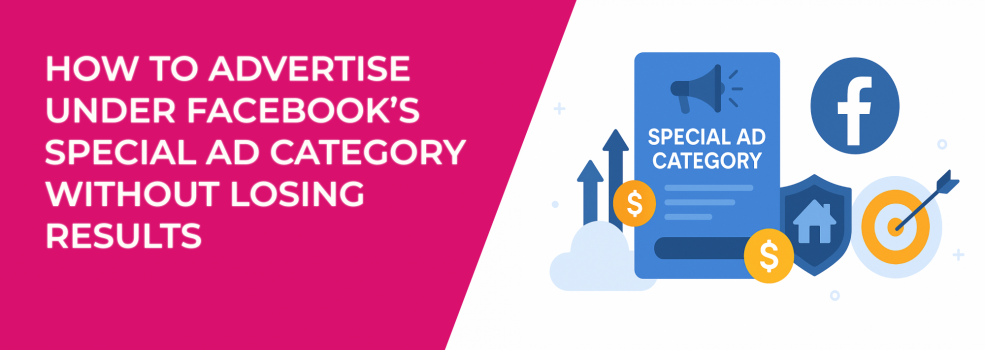If you’ve ever run ads in Facebook’s Special Ad Category, you know it feels restrictive. You lose some of your favorite targeting tools, audiences behave differently, and performance can slip if you don’t adjust.
But here’s the good news: advertisers who understand these rules can still get great results. In fact, some end up with campaigns that are more cost-efficient than before. Let’s take a closer look at how to make it work.
What Is the Special Ad Category and Why Does It Exist?
Facebook created the Special Ad Category to prevent unfair or discriminatory targeting. If your ads are related to housing, credit, or employment, your campaigns are automatically placed in this category.
Here’s what changes:
-
No targeting by age, gender, or ZIP code.
-
Interest targeting limited to broader categories.
-
Lookalike audiences replaced with “Special Ad Audiences.”
At first, this can feel like you’ve lost control. But these limits actually push you to focus on what really matters — your data, your creative, and your funnel strategy. If you’re not familiar with the latest rules, check out Meta Special Ad Category: What It Is and How to Stay Compliant.
Rethinking Targeting: Broader Is Better
Many advertisers assume narrow targeting is always best. Under the Special Ad Category, that’s no longer an option. Instead of resisting, think bigger.
When you open up your targeting, Facebook’s algorithm has more data to work with. More data means the system can learn faster and deliver your ads to the right people.
A few ways to make broad targeting effective:
-
Geographic focus: You can’t use ZIP codes, but you can still target by city or radius. This keeps your ads relevant to people in the right areas.
-
Behavioral signals: Broader interest categories like “financial services” or “career development” are still available. Use them to point Facebook in the right direction without over-limiting.
-
Smart exclusions: Exclude people who already converted, or who don’t fit your goals. This keeps your budget focused on new opportunities.
Want to go deeper on this? Take a look at Retargeting vs. Broad Targeting: Which Strategy Drives Better Results? for more perspective on how broader targeting can actually work in your favor.
Making the Most of Special Ad Audiences
Traditional lookalikes are powerful, but they aren’t allowed in the Special Ad Category. Instead, you get Special Ad Audiences. These are built on user behavior rather than demographics.
To get strong results with them:
-
Start with high-quality sources: Use data from past converters, applicants, or engaged visitors. The better the source, the better the audience.
-
Test different audience sizes: Don’t assume smaller audiences are always more accurate. Sometimes 3% or 5% Special Ad Audiences deliver better reach and cost efficiency.
-
Refresh your audiences regularly: If you use the same source data for too long, performance drops. Update your audiences every month or two.
If you’ve relied heavily on lookalikes before, you may also find Custom vs Lookalike Audiences: What Works Best for Facebook Campaigns? helpful as you re-think your approach.
Creative Becomes Your Targeting Tool
With fewer targeting options, your ad creative has to carry more weight. In many ways, your ad copy, images, and videos are now your “filters.” Good creative pulls the right people in and pushes the wrong people away.
Here are a few creative tips that work well in restricted categories:
-
Be specific: Say exactly what you offer. Clear, direct ads perform better than vague promises.
-
Try different formats: Video, carousel, and static ads all work differently. Testing multiple formats gives you a better chance of finding what resonates.
-
Speak to intent: Even if you can’t target by age or ZIP, you can craft messaging that resonates with people searching for a loan, a job, or housing support.
If you want more structure on building stronger creatives, see Crafting Compelling Facebook Ads Copy That Converts and The Ultimate Guide to Facebook Ad Formats.
Retargeting: The Secret Weapon
While prospecting is harder under the Special Ad Category, retargeting is still wide open. This is where you can win big.
Strong retargeting campaigns are built from:
-
People who visited your website or landing page.
-
Users who interacted with your Facebook or Instagram pages.
-
Video viewers who watched at least half of your content.
Retargeting ensures you don’t waste money chasing cold audiences over and over again. Instead, you keep building layers of engagement until people are ready to take action.
For a step-by-step framework, dive into How to Set Up Facebook Retargeting.
Testing and Data: Don’t Guess, Measure
The advertisers who succeed in Special Ad Categories are the ones who test relentlessly. Because the rules are different, old assumptions don’t always hold up.
Here’s how to approach testing:
-
Creative A/B tests: Change one element at a time — headline, image, or call-to-action — and see what performs best.
-
Offer testing: Try different angles. A lower interest rate? A faster application process? Different people respond to different hooks.
-
Budget distribution: Use Campaign Budget Optimization (CBO). Let Facebook decide where to place your spend, then scale what works.
For more details, check out Key Strategies for Facebook Ad Testing: What You Need to Know.
Final Thoughts
The Special Ad Category changes how you advertise, but it doesn’t mean you have to lose results. In fact, it can push you to become a sharper, more data-driven marketer.
By broadening your targeting, making smart use of Special Ad Audiences, improving your creative, and relying heavily on retargeting, you can build campaigns that are both compliant and effective. Pair that with ongoing testing, and you’ll not only survive under these rules — you’ll thrive.
If you’re still wondering whether the effort is worth it, read Are Facebook Ads Worth It?. Spoiler: they are — when you adapt your strategy the right way.

